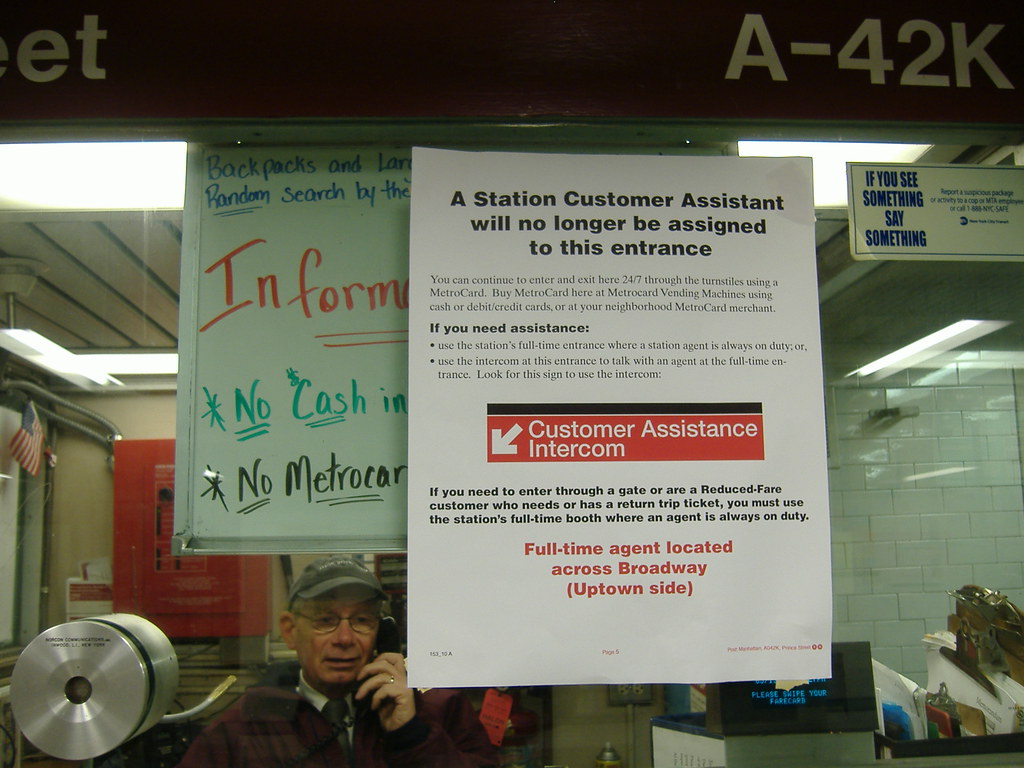In the Sunday Times this week, City Critic Ariel Kaminer profiled the MTA’s new contactless fare payment trial. I first introduced the trial in late May and discussed the impending end of the MetroCard swipe two weeks ago. In that sense, Kaminer’s piece is similar to the prior coverage. She tests the technology in New York City Transit’s subways, along the PATH trains and in New Jersey Transit buses and finds the intermodal system in various states of readiness.
Where her piece gets more interesting, however, is in its discussion of those who are and are not using the Pay Pass. “If news of this brave experiment hasn’t quite made its way to the bus drivers of the Garden State,” she writes, “it doesn’t seem to have seized the riders of Manhattan either. Stand at the PayPass turnstile in the Grand Central subway station and, I predict, your interest in technology and transportation will give out hours before you see anyone even try it.” A few straphangers with whom she spoke said they were interested in but had not planned to take advantage of the MTA’s six-month trial.
And so this begs the question: What good is a trial if no one comes? How will the MTA evaluate a technology in use along very few bus routes and only a select stops along one subway line? It can’t assess how the Pay Pass fares under the pressures of regular and heavy users of the transit system and is, for now, only as comprehensive as the trial makes it out to be. MTA officials assure me that they will consider these obstacles as they evaluate the trial, but until the authority prepares for a system-wide rollout of something else, I can’t get too excited for this fare payment technology of the future.


















 I have such mixed thoughts about the future of the Student MetroCard program. On the one hand, students in New York City should enjoy free rides to and from their public schools as every other public school student in the country does. On the other hand, the city and state — and decidedly not the MTA — should be picking up the tab for this benefit. On other other, other hand, I have to wonder why Albany can get so up in arms when Student MetroCards are threatened but can’t be bothered to lift a finger when buses and subway routes are eliminated.
I have such mixed thoughts about the future of the Student MetroCard program. On the one hand, students in New York City should enjoy free rides to and from their public schools as every other public school student in the country does. On the other hand, the city and state — and decidedly not the MTA — should be picking up the tab for this benefit. On other other, other hand, I have to wonder why Albany can get so up in arms when Student MetroCards are threatened but can’t be bothered to lift a finger when buses and subway routes are eliminated. It is the phantom subway station that just won’t fade away. It is the the phantom subway station that, for the sake of a neighborhood and New York City’s future, has to be built. And it is a phantom subway station that just might be inching one step closer to a return to reality.
It is the phantom subway station that just won’t fade away. It is the the phantom subway station that, for the sake of a neighborhood and New York City’s future, has to be built. And it is a phantom subway station that just might be inching one step closer to a return to reality.

 When residents who live along the M line from Bushwick to Middle Village wake up on June 27, they will find their commutes drastically altered. The M will no longer travel down Nassau St. and into Southern Brooklyn. Instead, with a new orange bullet denoting a Sixth Ave. trunk route, the M will take the Chrystie St. Cut to Broadway/Lafayette and make local stops up Sixth Ave. to Forest Hills. It is
When residents who live along the M line from Bushwick to Middle Village wake up on June 27, they will find their commutes drastically altered. The M will no longer travel down Nassau St. and into Southern Brooklyn. Instead, with a new orange bullet denoting a Sixth Ave. trunk route, the M will take the Chrystie St. Cut to Broadway/Lafayette and make local stops up Sixth Ave. to Forest Hills. It is